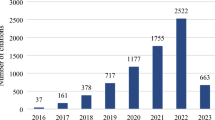Abstract
River formation dynamics (RFD) (Rabanal et al. in Using river formation dynamics to design heuristic algorithms. In: Unconventional computation, UC’07, LNCS 4618. Springer, pp 163–177, 2007; Rabanal et al. in Applying river formation dynamics to solve NP-complete problems. In: Chiong R (ed) Nature-inspired algorithms for optimisation, volume 193 of Studies in Computational Intelligence. Springer, pp 333–368, 2009) is a heuristic optimization algorithm based on copying how water forms rivers by eroding the ground and depositing sediments. We apply this method to solve the Steiner tree problem (STP), a well-known NP-hard problem having applications to areas like telecommunications routing or VLSI design among many others. We show that the gradient orientation of RFD makes it especially suitable for solving this problem, and we report the results of several experiments where RFD, as well as an implementation of Ant Colony Optimization (ACO) (Dorigo in ant colony optimization. MIT Press, New York, 2004), are applied to some benchmark graphs from the SteinLib Testdata Library (Koch in Steinlib testdata library. Technical report, Konrad-Zuse-Zentrum für Informationstechnik Berlin, 2009). We also study the capability of RFD and ACO to deal with a scenario where the graph is modified after a solution is found, and next a solution for the new graph has to be found - either by running the algorithm from scratch or by adapting the structures previously formed by the algorithms to construct their previous solution.









Similar content being viewed by others
Notes
Usually, this implies either to repeat a node or to kill the ant. In both cases, the last movements of the ant were useless.
References
Bern M, Plassmann P (1989) The Steiner tree problem with edge lengths 1 and 2. Inform Proc Lett 32:171–176
Caldwell A, Kahng A, Mantik S, Markov I, Zelikovsky A (1998) On wirelength estimations for row-based placement. In: International symposium on physical design. ACM Press, New York, pp 4–11
Chiong R (ed) (2009) Nature-inspired algorithms for optimisation. Volume 193 of studies in computational intelligence. Springer, Berlin
Clementi AEF (1999) Improved non-approximability results for minimum vertex cover with density constraints. Theor Comput Sci 225:113–128
Das S, Gosavi SV, Hsu WH, Vaze SA (2002) An ant colony approach for the steiner tree problem. In: GECCO’02: proceedings of the genetic and evolutionary computation conference, page 135. Morgan Kaufmann Publishers Inc., Orlando
Dorigo M (2004) Ant colony optimization. MIT Press, New York
Eiben AE, Smith JE (2003) Introduction to evolutionary computing. Springer, Berlin
Fleischer M (1995) Simulated annealing: past, present, and future. In: Proceedings of the 27th conference on winter simulation, pp 155–161
Hu Y, Jing T, Hong X, Feng Z, Hu X, Yan G (2004) An efficient rectilinear Steiner minimum tree algorithm based on ant colony optimization. In: IEEE ICCCAS. IEEE Computer Society Press, Los Alamitos, pp 1276–1280
Hwang F, Richards D, Winter P (1992) The steiner tree problem. North-Holland
Ivanov A, Tuzhelin A (1994) Minimal networks: the steiner problem and its generalizations. CRC Press, Cleveland
De Jong KA (2006) Evolutionary computation: a unified approach. MIT Press, New York
Kahng AB, Robins G (1995) On optimal interconnections for VLSI. Kluwer Publishers, Boston
Karp RM (1972) Reducibility among combinatorial problems. In: Miller RE, Thatcher JW (eds) Complexity of computer computations. Plenum Press, New York, pp 85–103
Kirkpatrick S, Gelatt CD Jr., Vecchi MP (1983) Optimization by simulated annealing. Sci Agric 220(4598):671
Koch T (2009) Steinlib testdata library. Technical report, Konrad-Zuse-Zentrum für Informationstechnik Berlin. http://steinlib.zib.de/steinlib.php
Korte B, Prömel HJ, Steger S et al (1990) Steiner trees in VLSI-layouts. In: Korte B (ed) Paths, flows and VLSI-layout. Springer, Berlin
Luyet L, Varone S, Zufferey N (2007) An ant algorithm for the steiner tree problem in graphs. In: EvoWorkshops 2007 on EvoCoMnet, EvoFIN, EvoIASP, EvoINTERACTION, EvoMUSART, EvoSTOC and EvoTransLog. Springer, Berlin, pp 42–51
Prossegger M, Bouchachia A (2008) Ant colony optimization for Steiner tree problems. In: 5th international conference on soft computing as transdisciplinary science and technology. ACM Press, New York, pp 331–336
Rabanal P, Rodríguez I, Rubio F (2007) Using river formation dynamics to design heuristic algorithms. In: Unconventional computation, UC’07, LNCS 4618. Springer, pp 163–177
Rabanal P, Rodríguez I, Rubio F (2008) Finding minimum spanning/distances trees by using river formation dynamics. In: Ant colony optimization and Swarm intelligence, ANTS’08, LNCS 5217. Springer, pp 60–71
Rabanal P, Rodríguez I, Rubio F (2009) Applying river formation dynamics to solve NP-complete problems. In: Chiong R (ed) Nature-inspired algorithms for optimisation, volume 193 of studies in computational intelligence. Springer, pp 333–368
Rabanal P, Rodríguez I, Rubio F (2009) A formal approach to heuristically test restorable systems. In: 6th international colloquium on theoretical aspects of computing—ICTAC 2009, LNCS 5684. Springer, pp 292–306
Rabanal P, Rodríguez I, Rubio F (2010) Applying river formation dynamics to the steiner tree problem. In: International conference on cognitive informatics (ICCI’10). IEEE Computer Society Press, Calgary
Robins G, Zelikovsky A (2000) Improved Steiner tree approximation in graphs. In: Eleventh annual ACM-SIAM symposium on discrete algorithms. Society for Industrial and Applied Mathematics, pp 770–779
Takahashi H, Matsuyama A (1980) An approximate solution for the Steiner problem in graphs. Math Japonica 24:6
Weise T, Chiong R (2009) Evolutionary approaches and their applications to distributed systems. In: Intelligent systems for automated learning and adaptation: emerging trends and applications, chap 6. pp 114–149
Acknowledgments
Research partially supported by projects TIN2009-14312-C02-01, and UCM-BSCH GR58/08—group number 910606.
Author information
Authors and Affiliations
Corresponding author
Rights and permissions
About this article
Cite this article
Rabanal, P., Rodríguez, I. & Rubio, F. Studying the application of ant colony optimization and river formation dynamics to the steiner tree problem. Evol. Intel. 4, 51–65 (2011). https://doi.org/10.1007/s12065-011-0049-0
Received:
Revised:
Accepted:
Published:
Issue Date:
DOI: https://doi.org/10.1007/s12065-011-0049-0




